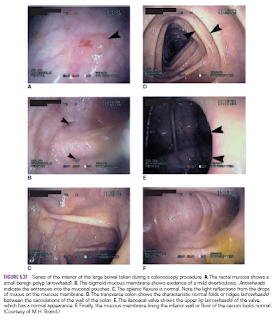Colonoscopy
colonoscopy is now
being extensively used for early detection of malignant tumors Since colorectal
cancer is a leading cause of death. In this procedure, the mucous membrane of
the colon can be directly visualized through an elongated flexible tube, or
endoscope. Following a thorough washing out of the large bowel, the patient is
sedated, and the tube is gently inserted into the anal canal. The interior of
the large bowel can be observed from the anus to the cecum. Photographs of
suspicious areas, such as polyps, can be taken and biopsy specimens can be
removed for pathologic examination. Although a relatively expensive procedure,
it provides a more complete screening examination for colorectal cancer than
combined fecal occult blood testing and the examination of the distal colon
with sigmoidoscopy .
Cancer
of the Large Bowel
Cancer of the large bowel is relatively common in persons older
than 50 years. The growth is restricted to the bowel wall for a considerable
time before it spreads via the lymphatics Bloodstream spread via the portal
circulation to the liver occurs late. If a diagnosis is made early and a
partial colectomy is performed, accompanied by removal of the lymph vessels and
lymph nodes draining the area, then a cure can be anticipated
Cecostomy
and Colostomy
Because the cecum, transverse colon, and sigmoid colon, they
may be brought to the surface through a small opening in the anterior abdominal
wall. If the cecum or transverse colon is then opened, the bowel contents may
be allowed to drain by this route. These procedures are referred to as
cecostomy or colostomy, respectively, and are used to relieve large-bowel
obstructions
Diverticulosis
The term diverticulitis refers to the inflammation of a
diverticulum or diverticula, and this may result in perforation of the gut wall
Diverticulosis of the colon is a common clinical condition. It consists of a
herniation of the lining mucosa through the circular muscle between the teniae
coli and occurs at points where the circular muscle is weakest—that is, where
the blood vessels pierce the muscle.



No comments:
Post a Comment